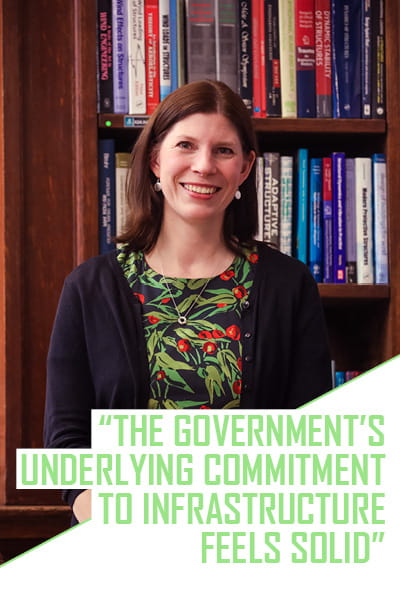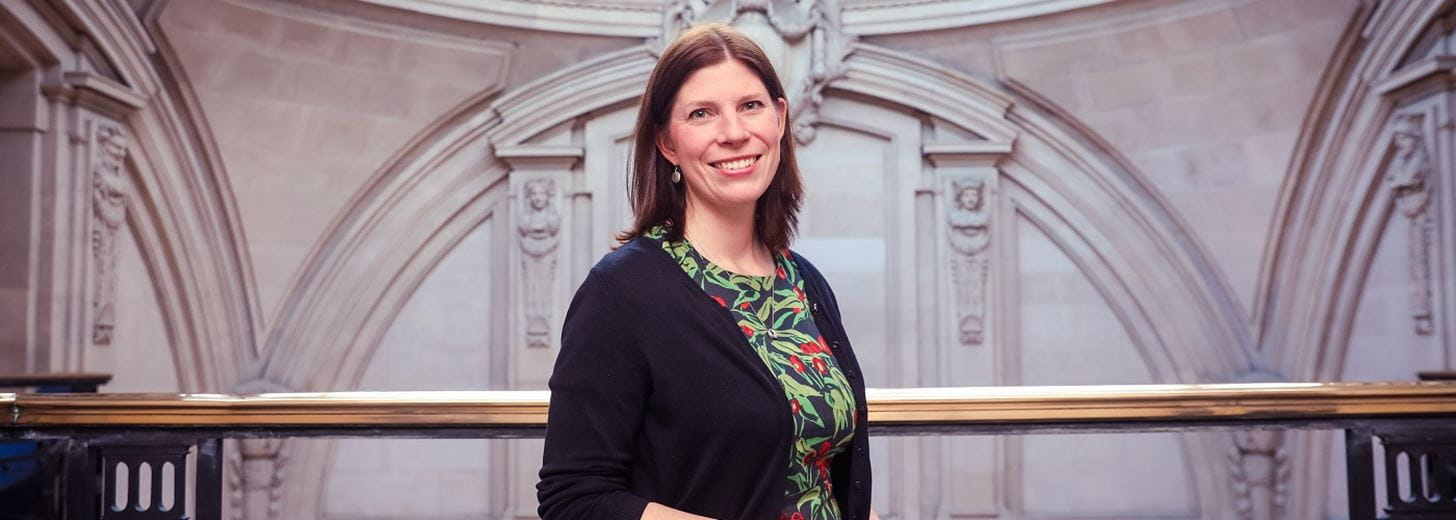Meet the incoming President of the Institution of Civil Engineers
Rachel Skinner will become the 156th President of the Institution of Civil Engineers in November 2020, the youngest ever in its 200-year history, and only the second woman to hold the post.
Originally trained as a geographer, she then qualified as a transport planner and now works in transportation consulting. She is a Fellow of the Royal Academy of Engineering and a recognised expert in future mobility. She is passionate about crafting the right links between placemaking, transport planning and technology, to bring through the best possible long-run outcomes for people, better productivity and high-quality places.
In late 2018, Rachel was made a Commissioner for the Infrastructure Commission for Scotland. She authored, in 2017, a key publication about autonomous vehicles and the place-making potential they offer – this remains at the leading edge and was specifically referenced in the DfT’s Future of Mobility publication in March 2019.
Rachel was one of The Telegraph’s inaugural Top 50 Women in Engineering in 2016 and, a year later, was recognised as both the “Most Distinguished Winner” and “Best Woman in Civil Engineering” at the European Women in Construction and Engineering awards. In November 2019, she was confirmed as one of the Financial Times’ Top 100 Women Influential in UK engineering.
We check in with Rachel to find out what the future holds for infrastructure, what challenges she faces in her new post, and how we can encourage diversity in the industry.
The future of UK infrastructure
The UK infrastructure pipeline is arguably in a very healthy place right now, with a great deal of public commitment to investment. Where do you see the challenges?
The current political situation still carries uncertainty, but the Government’s underlying commitment to infrastructure feels solid. The challenge is that two key drivers are shifting. First, technology is opening up the potential to deliver different types of infrastructure solutions, combining the physical and the digital in new ways. This will affect new projects as well as investment to adapt the infrastructure we’ve already got.
Second, the net zero carbon agenda is now at a point where it carries sufficient weight and public interest to shift our investment rationale. These changes bring great potential to reinvent the way that we all work together.
As a transportation professional, how do you see the public and private sector working more effectively together to accelerate investment to transform mobility?
There are two key groups who could collaborate for mutual benefit. The first is, rather obviously, the private sector: technology firms and mobility service providers who are keen to embed their products and services into the onward mix – particularly in our urban centres for now, but with a likely growing interest in the suburban and rural context over time. The second is the highly influential group of strategic landowners and investors, who are now realising that significant mobility-led changes are likely to emerge on the ground within their current strategic planning cycles to 2040 and beyond. This affects major new sites, which can take years to build out, and existing profitable portfolios that need to keep their edge.

We have not seen this scale of mobility change since post-war Britain. The growth in zero-emission vehicles is one of the change-curves to watch, especially with the public interest in climate change and net zero carbon goals. Closely linked is the acceleration of in-vehicle connectivity and the rapid shift in automation, which is gathering pace as suppliers race towards genuinely driverless solutions. In addition, each generation brings new expectations and norms. Young adults today, compared with previous generations, are far more willing to share, and less concerned about personal ownership of cars. They are far less likely to hold a driving licence and, as digital natives, they are used to trying out new mobility options to suit their individual needs.
Is this new mobility revolution realistic or even desirable – and, if so, by when?
Done well, these technologies are highly desirable. The future potential of mobility-led change holds the key to transformation in air quality, congestion, road safety and connectivity. It could also play a critical role in enhancing our quality of life, boosting the productivity of places and strengthening communities. Done badly, it could have the opposite effect. The last thing we need is to accidentally create a situation where we’re ‘fighting’ to ensure myriad transport systems meet our needs.
In response to the government’s recent future of mobility: urban strategy publication, you wrote that we need to guard against technology being introduced for its own sake. Why do you say that?
I feel very strongly that technological solutions – whether we’re talking about transport or anything else – should be driven first and foremost by the outcomes we’re trying to achieve. We then need to find the appropriate technologies to meet our strategic objectives – be they, for example, healthy communities, better productivity, cleaner air or less congested roads. In practice, this means that we need clarity around those desirable outcomes.
The challenges infrastructure is facing in 2020
You drive a fully electric car and have gone gas-free at home, thanks to a heat pump. What do you see as the major challenges yet to be overcome if these technologies are to be more widely rolled out across the UK?
Until we moved home a few years ago we were also early adopters of solar panel technology – and I have plans to reinstall those on our new roof as soon as I find time! As with any new technology, there will be wrinkles to iron out but, for me, the major challenge is around public perception and understanding. All too often, technologies remain a mystery to people who haven’t had the chance to see them in action. This is usually because we haven’t explained ‘what’s in it for them’ well enough. Right now, I suspect we will find that the explosion in carbon-awareness, not just in the UK but around the world, will become a fundamental pivot point for changing attitudes and increasing appetite for zero and low carbon lifestyle choices.
You take over as president of the institution of civil engineers in November 2020. How can you use this platform to influence change across the profession and ensure that we design sustainable solutions and help the UK to meet its net zero emissions targets by 2050?
Climate change and civil engineers’ response to the net zero carbon challenge will be the theme throughout my presidential year. There are so many ways that we can plan, design, deliver and operate economics and social infrastructure in ways that are less carbon-hungry – we have not yet scratched the surface. Some of these are easy wins without exorbitant price-tags. These actions, with a focus on the worst offenders, including building efficiency and transport emissions, can help us to dramatically reduce our carbon emissions and footprint over time. What I find exciting is that this is a genuinely global challenge; it is urgent and every sector, in every industry, will need to play a part in the long-run net zero carbon solution.
Diversity in the infrastructure industry
As a founder member and patron of women in transport, you are a passionate advocate for encouraging more women into engineering and across science and technology. How important is this for the industry?
As I didn’t study engineering as my first degree, I fell into the industry and gradually became aware of its lack of diversity. It isn’t just about gender but also many other characteristics. Diversity matters because we can only design, deliver and run the right infrastructure if we deeply understand the needs of our wider communities. This isn’t something you can fake or pretend to understand. There’s also a wealth of evidence that shows that a more diverse team makes better decisions and generates significantly better results across all metrics, so it is in our common interest to create a better balance.
Where do you still see the main gender barriers?
There are two key gender barriers that don’t always get the airtime they deserve. First, despite effort, we still have an (in)visibility challenge to overcome. You can’t choose a career that you can’t see. This is ironic, as the actual results of our work – iconic buildings and places, mobility, clean water, quality homes and workplaces with Wi-Fi, heat and power, and so on – are all very visible. Second, I think we need a radical change in the type of women we attract. At the moment, a lot of the women in STEM careers are there – like me – because they “don’t mind being different” or “have never been bothered when they’re the odd-one-out.” But, if we want to be truly diverse, we need to get into the mainstream consciousness – we can’t rely on the small minority who dare to be different.
As a senior and highly influential member of the engineering and built environment profession, are you confident that your generation will leave a positive legacy for generations to come?
As a hard-working mum to three school-age children, I’m finding my mid-career years to be an interesting time. My kids are now old enough to keep me brutally anchored around what matters to them and the legacy they want ‘us adults’ to leave. At the same time, I am well aware that those ahead of me in the built environment professions have spent their careers shaping the world and seeking to create good growth and change. Now is a fascinating time: for me, the carbon angle is the game-changer in terms of legacy – it will redefine what matters and why.
Latest news
- DEFRA has today opened the Improving Farm Productivity grant
- Carter Jonas Reports Half Year Results for 2020
- Carter Jonas Strengthens Rural South West Team With Senior Appointment
- Battery Energy Storage
- Carter Jonas signs-up to Time to Change initiative
- Raft of Promotions at Carter Jonas
- Carter Jonas Achieves Gold Investors In People Accreditation
- Newbury Straw Sale met with Selective Trade as Spring Approaches
- Newbury Straw Sale met with buoyant trade





